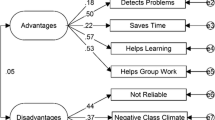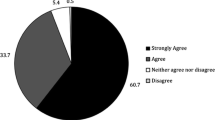Abstract
The use of peer assessment (PA) as an alternative form of evaluation method is reported to be helpful in learning and is increasingly being adopted in higher education settings. Through collecting data from 280 university students in Taiwan, a 20-item instrument was developed to investigate university students’ attitudes toward and perceptions of PA and online PA. Four subscales, Positive Attitudes, Online Attitudes, Understanding-and-Action, and Negative Attitudes, were extracted and reliabilities were calculated. Results revealed that participating students held positive attitudes toward the use of PA activities, but they viewed online PA as a technical tool to facilitate assessment processes, rather than as a learning aid. Male students had more positive attitudes toward PA than females did, and students with previous PA experiences had less negative attitudes toward PA. A majority of these students suggested that the PA score should be counted as a small part of the total course grade, and there was an effect of the perceived importance of PA score on students’ attitudes toward these four subscales.
Similar content being viewed by others
References
L. Arnold L. Willoughby V. Calkins L. Gammon G. Eberhart (1981) ArticleTitle‘Use of peer evaluation in the assessment of medical students’ Journal of Medical Education 56 35–42
R. Ballantyne K. Hughes A. Mylonas (2002) ArticleTitle‘Developing procedures for implementing peer assessment in large classes using an action research process’ Assessment & Evaluation in Higher Education 27 427–441 Occurrence Handle10.1080/0260293022000009302
D. Boud (1990) ArticleTitle‘Assessment and the promotion of academic values’ Studies in Higher Education 15 110–113 Occurrence Handle10.1080/03075079012331377621
C. Brindley S. Scoffield (1998) ArticleTitle‘Peer assessment in undergraduate programmes’ Teaching in Higher Education 3 79–89
S.A. Butler S.R. Hodge (2001) ArticleTitle‘Enhancing student trust through peer assessment in physical education’ Physical Educator 58 30–41
W. Cheng M. Warren (1997) ArticleTitle‘Having second thoughts: Student perceptions before and after a peer assessment exercise’ Studies in Higher Education 22 233–239 Occurrence Handle10.1080/03075079712331381064
S. Clegg D. Trayhurn A. Johnson (2000) ArticleTitle‘Not just for men: A case study of the teaching and learning of information technology in higher education’ Higher Education 40 123–145 Occurrence Handle10.1023/A:1004093116051
V.A. Clifford (1999) ArticleTitle‘The development of autonomous learners in a university setting’ Higher Education Research & Development 18 115–128
P. Davies (2000) ArticleTitle‘Computerized peer assessment’ Innovations in Education and Teaching International 37 346–355 Occurrence Handle10.1080/135580000750052955
N. Falchikov (1995) ArticleTitle‘Peer feedback marking: Developing peer assessment’ Innovations in Education and Teaching International 32 175–187
N. Falchikov (2001) Learning Together: Peer Tutoring in Higher Education Routledge Falmer London
N. Falchikov J. Goldfinch (2000) ArticleTitle‘Student peer assessment in higher education: A meta-analysis comparing peer and teacher marks’ Review of Educational Research 70 287–322
N. Falchikov D. Magin (1997) ArticleTitle‘Detecting gender bias in peer marking of students’ group process work’ Assessment & Evaluation in Higher Education 22 385–396
Fitzpatrick, C. (1999). ‘Students as evaluators in practicum: Examining peer/self assessment and self-efficacy’, Presented at the National Conference of the Association for Counselor Education and Supervision, New Orleans
L. Hatcher E.J. Stepanski (1994) A Step-by-Step Approach to Using the SAS System for Univariate and Multivariate Statistics SAS Institute Cary, NC
S.J. Hanrahan G. Issacs (2001) ArticleTitle‘Assessing self- and peer-assessment: The students’ views’ Higher Education Research & Development 20 53–70
C.B. Johnson F.I. Smith (1997) ArticleTitle‘Assessment of a complex peer evaluation instrument for team learning and group processes’ Accounting Education (JAI) 2 21–40
M. Lejk M. Wyvill (2001) ArticleTitle‘The effect of the inclusion of self-assessment with peer assessment of contributions to a group project: A quantitative study of secret and agreed assessments’ Assessment & Evaluation in Higher Education 26 551–561
L.J. LeMare K.H. Rubin (1987) ArticleTitle‘Perspective taking and peer interaction: Structural and developmental analysis’ Child Development 58 306–315
S.S.J. Lin E.Z.F. Liu S.M. Yuan (2001) ArticleTitle‘Web-based peer assessment: Feedback for students with various thinking-styles’ Journal of Computer Assisted Learning 17 420–432 Occurrence Handle10.1046/j.0266-4909.2001.00198.x
D. McConnell (2002) ArticleTitle‘The experience of collaborative assessment in E-learning’ Studies in Continuing Education 24 73–102 Occurrence Handle10.1080/01580370220130459
J. McGourty (2000) ArticleTitle‘Using multisource feedback in the classroom: A computer-based approach’ IEEE Transactions on Education 43 120–124 Occurrence Handle10.1109/13.848062
P. Orsmond S. Merry (1996) ArticleTitle‘The importance of marking criteria in the use of peer assessment’ Assessment & Evaluation in Higher Education 21 239–250
M.R. Paquet J.E. Marchais ParticleDes (1998) ArticleTitle‘Students’ acceptance of peer assessment’ Education for Health 11 25–35
L. Rubin (2002) ArticleTitle‘“I just think maybe you could...” Peer critiquing through online conversations’ Teaching English in the Two-Year College 29 382–392
K. Sambell L. McDowell (1998) ‘The values of self and peer assessment to the developing lifelong learner’ C. Rust (Eds) Improving Student Learning – Improving Students as Learners Oxford Center for Staff and Learning Development Oxford, UK 56–66
K. Scouller (1998) ArticleTitle‘The influence of assessment method on students’ learning approaches: Multiple choice question examination versus assignment essay’ Higher Education 35 453–472 Occurrence Handle10.1023/A:1003196224280
D. Sluijsmans F. Dochy G. Moerkerke (1999) ArticleTitle‘Creating a learning environment by using self-, peer- and co-assessment’ Learning Environment Research 1 293–319
H. Smith A. Cooper L. Lancaster (2002) ArticleTitle‘Improving the quality of undergraduate peer assessment: A case for student and staff development’ Innovations in Education and Teaching International 39 71–81
T.H. Spotts M.A. Bowman C. Mertz (1997) ArticleTitle‘Gender and use of instructional technologies: A study of university faculty’ Higher Education 34 421–436 Occurrence Handle10.1023/A:1003035425837
L. Stanier (1997) ArticleTitle‘Peer assessment and group work as vehicles for student empowerment: A module evaluation’ Journal of Geography in Higher Education 21 95–98
M.E Sullivan M.A. Hitchcock G.L. Dunnington (1999) ArticleTitle‘Peer and self assessment during problem-based tutorials’ The American Journal of Surgery 177 266–269 Occurrence Handle10.1016/S0002-9610(99)00006-9
K. Topping (1998) ArticleTitle‘Peer assessment between students in colleges and universities’ Review of Educational Research 68 249–276
C.-C. Tsai E.Z.-F. Liu S.S.J. Lin S.-M. Yuan (2001a) ArticleTitle‘A networked peer assessment system based on a Vee heuristic’ Innovations in Education and Teaching International 38 220–230
C.-C. Tsai S.S.J. Lin M.-J. Tsai (2001b) ArticleTitle‘Developing an Internet attitude scale for high school students’ Computers & Education 37 41–51 Occurrence Handle10.1016/S0360-1315(01)00033-1
C.-C. Tsai S.S.J. Lin S.-M. Yuan (2002) ArticleTitle‘Developing science activities through a networked peer assessment system’ Computers & Education 38 241–252 Occurrence Handle10.1016/S0360-1315(01)00069-0
E. Williams (1992) ArticleTitle‘Student attitudes towards approaches to learning and assessment’ Assessment and Evaluation in Higher Education 17 45–58
R. Zevenbergen (2001) ArticleTitle‘Peer assessment of student constructed posters: Assessment alternatives in preservice mathematics education’ Journal of Mathematics Teacher Education 4 95–113 Occurrence Handle10.1023/A:1011401532410
Author information
Authors and Affiliations
Corresponding author
Rights and permissions
About this article
Cite this article
Wen, M.L., Tsai, CC. University Students’ Perceptions of and Attitudes Toward (Online) Peer Assessment. High Educ 51, 27–44 (2006). https://doi.org/10.1007/s10734-004-6375-8
Issue Date:
DOI: https://doi.org/10.1007/s10734-004-6375-8




